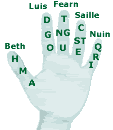כ"ט טבת ה'תשס"ז
In the previous entry discussing Dark Moon consecration of my athame, the (tips of the) index and middle fingers of the right hand will be used in tonight's ritual. Luis  and Fearn
and Fearn  are the two letters of the Ogham which correspond to the two ritual fingers.
are the two letters of the Ogham which correspond to the two ritual fingers.
Celtic luis (L) and fearn (F) correspond to Hebrew (ל) lamed and (ו) vav [1], respectively. The combined gematria of lamed-vav (לו) is 36. Thus, the two fingers of the right hand used in the ritual represent the completely righteous "revealed 36", while these two fingers of the left hand represent the completely righteous "concealed 36", for a total of 72.
Ogham stave alphabet:
Footnote:
[1] Mysteries Of The Alphabet, R' Marc-Alain Ouaknin (p. 172)
Technorati tags: Torah Talmud Torah Judaism Kabbalah jewish mysticism mysticism jewish meditation meditation shamanism jewish shamanism kabbalah iyunit kabbalah maasit jewitchery jewitch jewish woman sacred feminine divine feminine shechinah lilith spiritual development spirituality kosher spirituality ogham finger magick lamedvavnik
Thursday, January 18, 2007
Lamed-Vav Of The Ogham
Posted by
Lori
at
7:45 PM
![]()
Labels: finger magick, kabbalah, ogham, ritual
Subscribe to:
Post Comments (Atom)
Dare to be true to yourself.








1 comment:
UPDATE- comment on this post at Jewitchery LJ community:
Just a few minor things: the ogham aicme (groups of five letters) are not in the proper order on the second graphic you gave above: the first aicme is BLFSN, the second is HDTCQ. This is VERY IMPORTANT when it comes to the order of things as set out in some interpretations of the ogham alphabet. The HDTCQ one is incorrect, because C is always C and not lenited C ("Ch"); and the third aicme should have "Z" in place of "St" (even though the tree for that particular letter is usually given as Straif, the original system had "Z" there, as "St" was not a recognized double-consonant, and the medieval inventors of the tree ogham list had to put something in because "Z" had disappeared from the Irish language at that stage).
Also, the forfedha, the final group there that is various diphthongs, is not original to the system, it's a later invention (and one which evinces great variation as well as interpretation).
There is not much evidence for the various letters being connected to different parts of the hand/fingers, outside of Robert Graves' The White Goddess, which is of course mostly poetically-inspired reinterpretation rather than an actual reflection of the original tradition.
Post a Comment